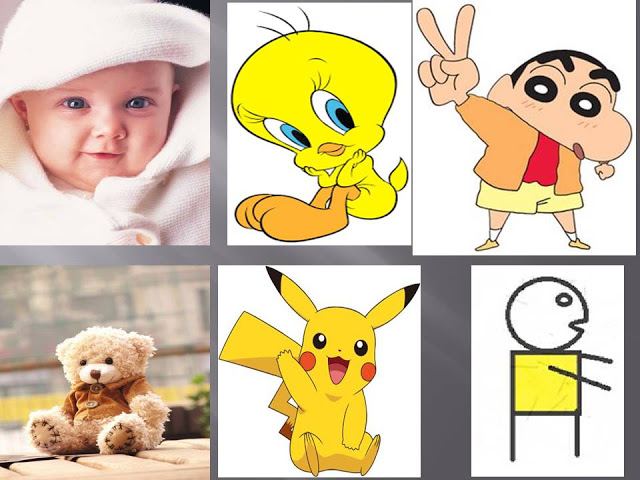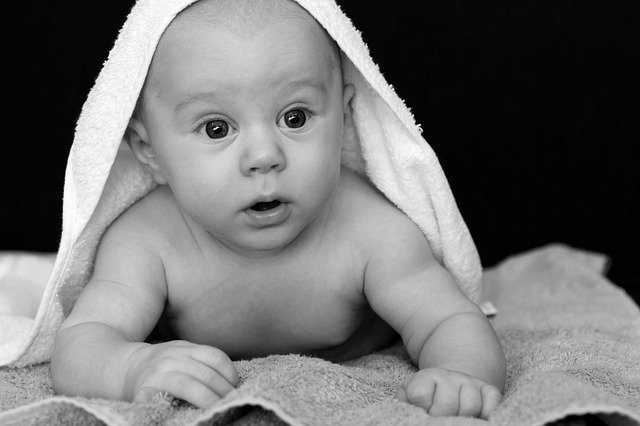Why are babies so cute and adorable? Why are we compelled, as if by some mysterious force, to hold and nurture cute babies?
According to Austrian scientist Konrad Lorenz, it’s all about the baby’s physical features. He discovered that certain features in human and animal babies trigger care-taking behaviors in parents.
Specifically, these features are:
- Large head relative to body size, rounded head
- Large, protruding forehead
- Large eyes relative to the face
- Rounded, protruding cheeks
- Rounded body shape
- Soft, elastic body surfaces
Animal babies are cute, too
The reason we find animal babies cute is that they share many of the cuteness features of human babies. Humans have bred pets (dogs, cats, rabbits, fish, etc.) to look cuter over generations.
This tendency of ours to adore cuteness features spills over to cartoon characters and baby dolls (think of Pikachu, Shinchan, Tweety, Mickey Mouse, etc.).
Cartoon characters are usually drawn with large heads, large eyes, and large foreheads. Often, the neck is omitted to make the characters look cuter by increasing the size of the head relative to body size.
Almost all the animal toys and baby dolls available in the market show similar features. Teddy bears, when they were first launched, looked more like baby bears. Gradually, they evolved to look more like human babies.
Presumably, marketers noticed that customers were more intent on buying teddy bears that had physical features resembling those of human babies.
Similarly, when Mickey was first drawn, it looked more like a mouse than a human. Over time, it looked more human-like, with features resembling those of human babies.

The purpose of cuteness in babies
Corroborating Konrad Lorenz’s discovery, a study showed that people who viewed baby photos with faces manipulated to look more infantile felt a stronger drive to take care of them.1
Human babies, when they’re born, are helpless and cannot survive on their own. Therefore, it only makes sense that we have evolved psychological mechanisms to provide care and nurturing to them when they need it the most.
It’s worth noting that when children grow up and need less care, their cuteness dwindles away.
Another factor at play here is the fact that babies are disgusting, unhygienic, mostly self-centered, and mannerless.
They throw tantrums and demand undivided attention. They puke and poop and are unable to clean up after themselves. Their diapers need to be changed frequently.
So evolution had to program parents with a strong drive to look after their babies. A drive so powerful it could override the disgust and aversion that babies induce.
When exposed to soiled diapers of infants, mothers consider the smell from their own child’s diaper less disgusting, despite not knowing which diaper belonged to which kid.2
Not all babies are cute
The fact that we don’t find all babies cute is a corollary of what we’ve discussed so far. If we find babies cute because of their cuteness features, then those babies who lack these features should appear less cute to us. But why?
One reason could be that cute babies that display cuteness features are actually healthier than babies who lack these features.
It’s known, for example, that babies with low body weight tend to be unhealthy. Reduce body weight, and you also reduce body roundness and chubby cheeks, making the baby less cute.
When participants in a study were shown pictures of baby faces reflecting low body weight, their ratings of adoption preference, cuteness, and health were significantly lower.3
In other words, people find sickly babies less cute and are less motivated to take care of them. It makes sense from an evolutionary perspective because unhealthy babies are less likely to survive and pass on their genes.
Cute babies and women
Since women are more into nurturing babies than men, they should be more sensitive to cuteness in babies. They should also be more willing to nurture babies if the opportunity presents itself.
Studies show that while women can reliably choose the cuter infant, men have difficulty in doing so.4
Common experience also tells us it’s true. Women are more likely to notice cute babies, animals, and things. It’s usually women, not men, who go “Awwww” when they see an online video of a baby rolling on the floor.
Women sometimes find babies and things cute that men don’t. Cuteness detection in women is so strong that they sometimes find everything small cute.
Mini laptops, mini-gadgets, mini-bags, and mini-cars are all cute for women. It’s like they transfer their maternal instincts onto every little version of a big thing they encounter.
References:
- Glocker, M. L., Langleben, D. D., Ruparel, K., Loughead, J. W., Gur, R. C., & Sachser, N. (2009). Baby schema in infant faces induces cuteness perception and motivation for caretaking in adults. Ethology, 115(3), 257-263.
- Case, T. I., Repacholi, B. M., & Stevenson, R. J. (2006). My baby doesn’t smell as bad as yours: The plasticity of disgust. Evolution and Human Behavior, 27(5), 357-365.
- Volk, A. A., Lukjanczuk, J. M., & Quinsey, V. L. (2005). Influence of infant and child facial cues of low body weight on adults’ ratings of adoption preference, cuteness, and health. Infant Mental Health Journal, 26(5), 459-469.
- Lobmaier, J. S., Sprengelmeyer, R., Wiffen, B., & Perrett, D. I. (2010). Female and male responses to cuteness, age and emotion in infant faces. Evolution and Human Behavior, 31(1), 16-21.

